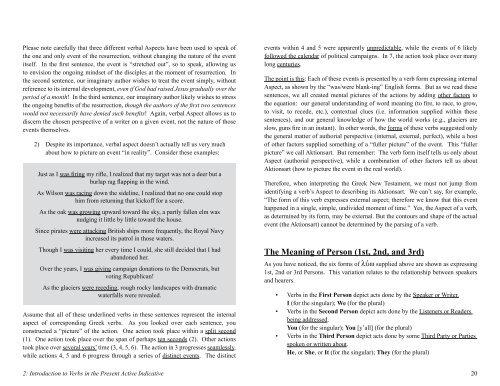Elementary New Testament Greek, 2014a
Elementary New Testament Greek, 2014a
Elementary New Testament Greek, 2014a
You also want an ePaper? Increase the reach of your titles
YUMPU automatically turns print PDFs into web optimized ePapers that Google loves.
Please note carefully that three different verbal Aspects have been used to speak of<br />
the one and only event of the resurrection, without changing the nature of the event<br />
itself. In the rst sentence, the event is “stretched out”, so to speak, allowing us<br />
to envision the ongoing mindset of the disciples at the moment of resurrection. In<br />
the second sentence, our imaginary author wishes to treat the event simply, without<br />
reference to its internal development, even if God had raised Jesus gradually over the<br />
period of a month! In the third sentence, our imaginary author likely wishes to stress<br />
the ongoing benets of the resurrection, though the authors of the rst two sentences<br />
would not necessarily have denied such benets! Again, verbal Aspect allows us to<br />
discern the chosen perspective of a writer on a given event, not the nature of those<br />
events themselves.<br />
2) Despite its importance, verbal aspect doesn’t actually tell us very much<br />
about how to picture an event “in reality”. Consider these examples:<br />
Just as I was ring my rie, I realized that my target was not a deer but a<br />
burlap rag apping in the wind.<br />
As Wilson was racing down the sideline, I realized that no one could stop<br />
him from returning that kickoff for a score.<br />
As the oak was growing upward toward the sky, a partly fallen elm was<br />
nudging it little by little toward the house.<br />
Since pirates were attacking British ships more frequently, the Royal Navy<br />
increased its patrol in those waters.<br />
Though I was visiting her every time I could, she still decided that I had<br />
abandoned her.<br />
Over the years, I was giving campaign donations to the Democrats, but<br />
voting Republican!<br />
As the glaciers were receding, rough rocky landscapes with dramatic<br />
waterfalls were revealed.<br />
Assume that all of these underlined verbs in these sentences represent the internal<br />
aspect of corresponding <strong>Greek</strong> verbs. As you looked over each sentence, you<br />
constructed a “picture” of the action. One action took place within a split second<br />
(1). One action took place over the span of perhaps ten seconds (2). Other actions<br />
took place over several years’ time (3, 4, 5, 6). The action in 3 progresses seamlessly,<br />
while actions 4, 5 and 6 progress through a series of distinct events. The distinct<br />
2: Introduction to Verbs in the Present Active Indicative<br />
events within 4 and 5 were apparently unpredictable, while the events of 6 likely<br />
followed the calendar of political campaigns. In 7, the action took place over many<br />
long centuries.<br />
The point is this: Each of these events is presented by a verb form expressing internal<br />
Aspect, as shown by the “was/were blank-ing” English forms. But as we read these<br />
sentences, we all created mental pictures of the actions by adding other factors to<br />
the equation: our general understanding of word meaning (to re, to race, to grow,<br />
to visit, to recede, etc.), contextual clues (i.e. information supplied within these<br />
sentences), and our general knowledge of how the world works (e.g., glaciers are<br />
slow, guns re in an instant). In other words, the forms of these verbs suggested only<br />
the general matter of authorial perspective (internal, external, perfect), while a host<br />
of other factors supplied something of a “fuller picture” of the event. This “fuller<br />
picture” we call Aktionsart. But remember: The verb form itself tells us only about<br />
Aspect (authorial perspective), while a combination of other factors tell us about<br />
Aktionsart (how to picture the event in the real world).<br />
Therefore, when interpreting the <strong>Greek</strong> <strong>New</strong> <strong>Testament</strong>, we must not jump from<br />
identifying a verb’s Aspect to describing its Aktionsart. We can’t say, for example,<br />
“The form of this verb expresses external aspect; therefore we know that this event<br />
happened in a single, simple, undivided moment of time.” Yes, the Aspect of a verb,<br />
as determined by its form, may be external. But the contours and shape of the actual<br />
event (the Aktionsart) cannot be determined by the parsing of a verb.<br />
The Meaning of Person (1st, 2nd, and 3rd)<br />
As you have noticed, the six forms of supplied above are shown as expressing<br />
1st, 2nd or 3rd Persons. This variation relates to the relationship between speakers<br />
and hearers.<br />
<br />
<br />
<br />
Verbs in the First Person depict acts done by the Speaker or Writer.<br />
I (for the singular); We (for the plural)<br />
Verbs in the Second Person depict acts done by the Listeners or Readers<br />
being addressed.<br />
You (for the singular); You [y’all] (for the plural)<br />
Verbs in the Third Person depict acts done by some Third Party or Parties<br />
spoken or written about.<br />
He, or She, or It (for the singular); They (for the plural)<br />
20


















